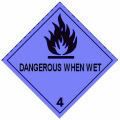Carryfast:
But then again Dave why bother with all the numbers and codes if maybe in the real world it might be better to just identify the actual stuff being carried so the first person/s at the scene who could be any idiot like me could just phone in with exactly what it is and then they know what they are dealing with right from the beginning anyway
Hi Carryfast, That because foreign types insist on speaking strange languages.
Dangerous goods are shipped worldwide, so there needs to be a system that gets past the problems caused by all those different languages.
The UN has decided that there is a worldwide four-digit numbering system, which nicely avoids languages and fancy-sounding chemical names as mentioned by Wheel Nut.
Here’s the way it works… (Remember the order that I wrote UN 1223 KEROSENE, 3, PGIII)
Let’s imagine a tank container full of Kerosene was loaded in Russia and arrived at the docks… a driver picks up the tank container, then studies the paperwork to discover: â„– OOH 1223 КЕРОϹИÐ, 3, ГУIII
The driver doesn’t actually need to know what the stuff is, but DOES need to know about the “3” and the “III,” so he understands that it’s a flammable liquid that’s not awfully dangerous. That’s why the order that the info is written on the paperwork is so important that it’s a legal requirement. The letters “КЕРОϹИД are very similar to the English “KEROSIN” so if somebody had a slight grasp of the Cyrillic alphabet, they could guess the word.
Now for a proper one:
КИCЛОТРCЕРÐÐЯ. For all we know at this point, it could mean “bacon butty.” 

Written correctly:
â„– OOH 1830 КИCЛОТРCЕРÐÐЯ, 8, ГУII
Again, we don’t really need to know what it is, but we can tell it’s a corrosive from the “8” and that it’s medium nasty from the “II”
Transliterating that into our alphabet gives: KISLOTA SERNAYA, so there’s still no clue as to what it is.
A look in any modal Regs (ADR, IMDG, RID, IATA or ADN) written in English tells us that it’s UN 1830 SULPHURIC ACID, 8, PGII
Here’s some 'orrible stuff written in German, can you guess what ‘stuff’ it is?
UN 1830 SCHWEFELSÄURE, 8, VGII
That proves that foreign languages and/or big long unreadable fancy chemical names are completely irrelevant. 
Carryfast:
and the fire brigade should know what to use without being told by the numbered codes anyway too?
They do if they first know the four-digit number for what ‘stuff’ they’re up against. 
 Imagine trying to phone 999 and say this chemical name after a couple of beers:
Imagine trying to phone 999 and say this chemical name after a couple of beers:
DICHLORODIFLUOROMETHANE AND DIFLUOROETHANE AZEOTROPIC MIXTURE
I’d find it easier to say that it’s UN 2602, but that’s just me. 
Carryfast:
As for those flash points and ignition points whoever happens to be in the vicinity wether it’s the driver or the public need to know that it’s not a case of the whole load needing to be at those temperatures before the whole load could go up.A large leak from a ruptured tank coming into contact with something like an electrical short in a broken cable (like that concorde example) can/ will ignite every part of the load that is in contact with the oxygen in the air by chain reaction from the first small part that ignited regardless of wether the rest of the load is below ignition or flashpoint temp?.
That’s quite true mate, but it’s the sort of thing that you’d need to discuss with a trained and qualified firefighter. My qualifications and remit are as an ADR instructor and ADR Regs consultant (DGSA,) apart from those, I’m an (almost) ex-LGV driver with no in-depth fire training, so I can only tell anybody what ADR and UK Regs say about subjects raised as questions by our forum members. To answer your question, an ADR vehicle driver is trained on an ADR course to know the hazards arising from the carriage of dangerous goods and what to do in an emergency as per the syllabus set by the DfT. WADR mate, if you have a concern about that, I’d suggest that you take it up with the fire-brigade or the DfT, because I’m not qualified on fire-theory or to comment on what should or shouldn’t be written in the law, cos I’m only a foot soldier in the grand scheme of things. 
![]()
![]()
![]()
![]()
![]()
![]() , that if it does even get transported.
, that if it does even get transported.